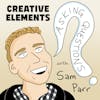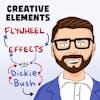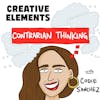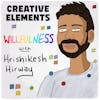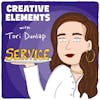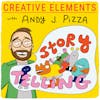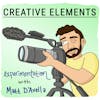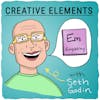
#184: Amy Porterfield – Her step-by-step process for MASSIVE product launches.
Play EpisodeAmy Porterfield is an online marketing legend who has done several multi-million dollar course launches.
Amy Porterfield is an online marketing expert and the creator of a multimillion dollar education business. Now you may know Amy from her top ranked marketing podcast called Online Marketing Made Easy or her new best selling book, Two Weeks Notice.
She is a legend after all. Amy quit her job in 2009 and started out on her own. In 2011, she launched her first course, but despite her background and experience, that course was a total flop earning just $26. She tried again in 2012, and this time, she earned $30,000 from her course launch. Then in 2013, she launched her podcast and really hit her stride. In 2013, Amy posted $915,000 in revenue.
Amy has now built an online marketing machine. With 22 employees and millions of dollars in revenue each year, Amy has really nailed both evergreen sales and course launches. Her launch formula leverages the use of webinars.
In this episode you'll learn
- The specific step by step strategy that Amy uses for her course launches
- How she builds her email list during the launch period
- How to be more successful in selling through those webinars even when you're sitting in the sale part of it
- And if you stick around towards the end, we even dig into how she's thought about building her team
Full transcript and show notes
Amy's Website / LinkedIn / TikTok / Instagram
***
CONNECT
📫 Get my Professional Creator Crash Course (free)
🧰 Get my full gear list (free)
🙏 Make a guest or mailbag request
📝 Check out our curated Playlists
***
SPONSORS
💼 View all sponsors and offers
***
SAY THANKS
💜 Leave a review on Apple Podcasts
Learn more about your ad choices. Visit megaphone.fm/adchoices
Amy Porterfield [00:00:00]:
Most of us have way too many plates spinning in the air. We say yes to way too much because of FOMO. We don't wanna be left out, And we're trying to figure it all out, so maybe that's good, maybe that is, maybe that is, but we don't become really good at anything.
Jay Clouse [00:00:27]:
Hello, my friend. Welcome back to another episode of Creator Science. I'm excited to have some time here with you today. I am speaking with the legend, Amy Porterfield, an online marketing expert and the creator of a multimillion dollar education business. Now you may know Amy from her top ranked marketing podcast called Online Marketing Made Easy or her new best selling book, 2 Weeks Notice, Find the Courage to Quit Your Job, Make More Money, Work Where You Want, and Change the World. I've been familiar with Amy's work for a long time. She is a legend after all. But I didn't know that Amy started as a corporate marketing employee.
Amy Porterfield [00:01:02]:
And I had a really cool boss, Tony Robbins, for about 7 years, And I got to travel the world with Tony and work on the content that he does on stage, and I got paid well. So that all was good. But there was this desire for more freedom that really I couldn't shake.
Jay Clouse [00:01:19]:
Okay. Working for Tony Robbins, no big deal. Anyway, Amy quit her job in 2009 and started out on her own. In 2011, she launched her first course, but despite her background and experience, that course was a total flop earning just $267 And Amy says that she could have avoided this disappointing outcome if she had just learned from someone else who had done this before.
Amy Porterfield [00:01:45]:
My $267 launch was hunting and pecking all over the web, hoping that I understood what someone was doing, but I had no clue. And it was really, really frustrating when it didn't work out.
Jay Clouse [00:01:58]:
But Amy didn't give up here and a lot of people would. In fact, a lot of people do. But she tried again in 2012. And this time, she earned $30,000 from her course launch. Then in 2013, she launched her podcast and really hit her stride. In 2013, Amy posted $915,000 in revenue.
Amy Porterfield [00:02:20]:
I decided that I was going to do less but make more money. And this is something that I I live by in my business now 14 years later.
Jay Clouse [00:02:30]:
Don't worry. We dive more into that in the interview. Amy has now built an online marketing machine. With 22 employees and 1,000,000 of dollars in revenue each year, Amy has really nailed both evergreen sales and course launches. And her launch formula leverages the use of webinars, a strategy she really digs into in this conversation. Now if you're like me, webinars may feel a little bit uncomfortable, a little challenging, So I'm asking you to keep an open mind here because Amy convinced me in this conversation.
Amy Porterfield [00:03:00]:
I had to show up on 10, 20 webinars before I started to feel more confident in my ability to sell on a webinar. So also, it's just practice. Your first few are gonna be terrible, but I want everyone to hear me here. It is not enough to email your list or social media and send them to a sales page. Sales pages at best convert about 5% on average. Webinars, when done right, 10 to 12%. I've even had 20% on a webinar.
Jay Clouse [00:03:29]:
So in this episode, you'll learn the specific step by step strategy that Amy uses for her course launches. We talk about how she builds her email list during the launch period, how to be more successful in selling through those webinars even when you're sitting in the sale part of it. And if you stick around towards the end, we even dig into how she's thought about building her team. I ask a lot of questions here.
Amy Porterfield [00:03:51]:
Your questions are so good, and these are all the things I love to talk about. So this is, like, the best interview ever.
Jay Clouse [00:03:57]:
I'd love to hear what you think about this episode. You can find me on Twitter or Instagram at jklaus. Tag me. Let me know what you think. I love hearing from you. And by the way, I was struggling with a little bit of a cold when we recorded this, so I apologize for my voice, especially here at the start. But now, I hope you enjoy this conversation with Amy Porterfield.
Amy Porterfield [00:04:22]:
So when I left corporate, which now it's about 14 years ago, I truly left because I wanted to be my own boss. I didn't wanna be told what to do, when to do it, or how to do it. So I left my corporate job, and my goal was to create digital courses and teach people how to do online marketing, which is what I did there. And so I went out, and I looked around on Instagram and Facebook, and everyone else seemed to be making a $100,000 with their launches, so why wouldn't I? And I was so naive. So I created this digital course on a topic that I wasn't an expert in. So now I teach people how to create digital courses, and one of the things I teach is to find your 10% edge. Where have you gotten results for yourself or for somebody else that you could teach how you got those results inside of a course? Well, I was teaching people how to launch a book using social media. I had never launched a book in my life.
Amy Porterfield [00:05:17]:
I don't know why I thought I needed to do that. There was this desperation I had. I I need to be I need to put myself on the map. I need to niche down. So I decided to teach book launching through social media. I knew social media well. I didn't know book launching, so when I went to go sell it, I had zero confidence and a very small email list. And so I made $267 I made a little bit more, but once you back out a few expenses, I didn't even make enough to cover a unit.
Amy Porterfield [00:05:46]:
Of course, it was 297. I didn't even make enough to cover 1 unit. Cried for a week, told myself I wasn't cut out to be an entrepreneur. This is never going to work. I'm a failure. I'm gonna have to grovel back for my job. Like, it was bad. Thank God I had my husband in my life at the time, still do, but he was really a huge support where he's like, you need to shake this off.
Amy Porterfield [00:06:08]:
Do you wanna go back to your job? And that's where that idea of freedom, no. I left because I wanted to be my own boss. So he kinda pushed me back out there to try again.
Jay Clouse [00:06:17]:
Having a spouse is such a game changer, and one of the things that I feel like a lot of creators who are having success don't talk about enough. I look back at where I was before I met my wife, and the business was essentially nothing. And I don't think it's a coincidence that, you know, today, it's grown quite a bit like having a supportive spouse just goes so so so far.
Amy Porterfield [00:06:40]:
It really does.
Jay Clouse [00:06:41]:
You looked around and a lot of people are making $10,000 with their launches. You figured I could do that too. That's still a story for a lot of people listening to this today. They're looking around and they're seeing these people doing these 6 figure launches seemingly every week and they think is it too late? Can I still do that? And so, you know, that was 10 years ago. This is a recurring theme. I would assume your response to that is it's not too late that this is still something that people can break through and do on their own.
Amy Porterfield [00:07:08]:
It is. And it's not just because I'm biased because I teach people how to take their knowledge, know how, and skill set and turn that into a digital course, but because I see proof every single day. And the beautiful thing is that the silver lining that came out of COVID is that more and more people are open to learning through digital learning, e learning. And so before COVID, there were people that were, like, no. I wanna learn guitar. I'm gonna go to my class in town, and I'm gonna learn in a group, and you gotta be with someone to learn something like that. It's more tangible. And then COVID happened, and they realized, wait a second, I could absolutely learn anything I want to learn online.
Amy Porterfield [00:07:46]:
I don't have to get dressed. I don't have to get in the car. I don't have to pay for in person lesson. E learning is cheaper and easier and on my own time. So it opened up a world to people that thought this is possible. So we saw a really big boom in digital course sales in 2020, and we've continued to see the climb. It is a multi $1,000,000,000 business, and it's only on the climb, and I really do believe it's because more and more people are open to this, and they've seen the ease of use with e learning. But also on the flip side, people like you and me, we see the value of creating content through digital courses, and selling one to many.
Amy Porterfield [00:08:24]:
Many of my students are 1 on 1 coaches, or they do small group coaching, or they do consulting. And you will always hit a ceiling when you are doing 1 on 1 work. So digital courses allow you to open up so you could sell all over the world one to many. So we do see that it is still on the rise.
Jay Clouse [00:08:44]:
So what was the difference in 2012 when you went from this $267 launch to a $30,000 launch? What changed?
Amy Porterfield [00:08:51]:
2 big things changed. Number 1 is that I decided to teach on my 10% edge, which was I took the book launch part out, which I wasn't an expert in, and I taught just how to use social media to build a business. So specifically, it was mainly Facebook at the time, and so I went really with my core competencies and doubled down there. The other thing is I started to grow my email list, something I teach my students. I really do believe that you don't have a thriving viable business or it's very hard to create one if all you're focused on is a social media presence. Having an email list is one of the most important assets in your business that you own. I always say when you just use social media to grow your business, you're growing your business on rented land. And at any time, Mark Zuckerberg or Elon Musk can change that algorithm, and boom, the way you did business will change overnight.
Amy Porterfield [00:09:43]:
So I started to grow an email list, which gave me more confidence, and then I started to put myself out there in an area I knew well, and that changed everything.
Jay Clouse [00:09:53]:
The next point on this timeline I guess it's technically 2 points ahead. But 2012, $30,000 launch. 2013, $915,000 in the year. What happened in that year?
Amy Porterfield [00:10:06]:
So here's exactly what happened. 1, I decided that I was going to do less, but make more money. And this is something that I I live by in my business now 14 years later. I knew that, okay, I actually created a digital course and I'm pretty good at doing webinars and selling online. Who knew? I didn't. So I started doing that more and more, and I got really good at selling my digital courses through webinars. And so I thought, you know what? I'm not going to create another course. I'm going to take this course, make it better based on what I learned in my last launch.
Amy Porterfield [00:10:41]:
And because I'm getting better at webinars and selling and showing up, I'm going to launch it again. So I launched the course again, and then I launched it again. And the course changed each time. It actually, I changed the title and the topic. It used to be all social media, then I got more focused on Facebook. So I got really dialed in. And so I launched the same course over and over and over again. And every time my email list got bigger, because when you launch something online and you do something like a boot camp, a challenge, a webinar, you start growing your email list organically while you're launching.
Amy Porterfield [00:11:19]:
So after every launch, my email list got bigger. And so as my email list got bigger, so did my revenue for each of the launches. So it was I did less to make more, and I took what I was good at, and I just got better at it, which is really hard for a lot of multi passionate entrepreneurs. Most of us have way too many plates spinning in the air. We say yes to way too much because of FOMO. We don't wanna be left out. And we're trying to figure it all out, so maybe that's good, maybe that is, maybe that is, but we don't become really good at anything. And so early on, I became really good at one thing, and I stayed in my lane.
Amy Porterfield [00:11:57]:
I really acted as though I was a race horse. When you're in a race with a race horse, they have blinders on. They can't look left or right, only forward. So I stopped looking at what everyone else was doing because I would be so tempted to try it all. I just kept looking forward, and it really made a huge difference.
Jay Clouse [00:12:14]:
How many launches would you say you did in that year?
Amy Porterfield [00:12:19]:
I think I did 4 or 5 in 2013.
Jay Clouse [00:12:23]:
Wow. Wow. Wow. And and to you, what was, like, a launch cadence? How long were you doing the launch?
Amy Porterfield [00:12:30]:
So when I first started out, I remember my very first successful launch was 21 days. I will never do that again, nor will I ever teach that. It's just way too long to be in the game. One of the things I love about teaching people how to create digital courses, one thing I personally love about launching them, is that you're in and you're out. I love white space. I love when I'm not promoting. Right now, I'm not promoting anything. I just get to put out really great valuable content and do my podcast.
Amy Porterfield [00:12:56]:
I love that. And so the cadence that I teach now and I've been doing for years years is about an 8 to 10 day cart open. So I teach 30 days of leading up to cart open, and that's when you've got freebies, you're giving amazing value, you're going live on social more, you're maybe getting interviewed on different podcasts, you're really putting yourself out there, all free value. You're not mentioning your course, you're not selling anything. And then once the launch starts, for me, it would be that's when I start doing my live webinars. That's when the cart opens. And for 10 days, you could buy my program. And at the end of that 10 days, you can no longer buy it.
Amy Porterfield [00:13:35]:
And so that scarcity and that urgency and that cadence makes a huge difference. Now, I also teach Evergreen. I have a digital course. I have 2 digital courses in one membership. That's my product suite. And one of my digital courses is $500. It's all about list building, and that's on Evergreen. I sell it every single day through automated webinars.
Amy Porterfield [00:13:55]:
And now, once a year, I do one really big launch with a course teaching you how to create and launch a digital course. And I do that one for 10 days once a year. And then I have a membership that I do all the time. So I love the cadence of live launching in Evergreen.
Jay Clouse [00:14:11]:
After a quick break, Amy and I get into the specifics of her course launch strategy. So stick around. We'll be right back. And now back to my conversation with Amy Porterfield.
Amy Porterfield [00:14:23]:
So I start out my launch with, 2 webinars on day 1, usually 2 webinars on day 2. I usually open a cart on a Tuesday. So 2 webinars on Tuesday, 2 webinars on Wednesday, and then I'll let a few days go by, and I'll usually do one on a weekend, like a Saturday or Sunday for those that can't make the weekly. So I usually do 5 live webinars. Now, this is the question I always get asked. Is it the same webinar every time? Absolutely. I'm just giving multiple dates and times. There is a higher perceived value when something is live.
Amy Porterfield [00:14:59]:
It's incredible. If I do the exact webinar live and then record it and then put that exact webinar on automation, When I'm live, all I hear is, is this live? Is this live? Is this live? It could be the exact same thing on Nevergreen, but people wanna know that you're there with them live, especially since COVID. That connection is important. So I do the exact same webinar 5 times at least live throughout 10 days. But the secret is every time it gets better, there's a nuance. I'll remember, like, I'll get off the webinar and think, oh, I didn't like that transition. Right away, I fix it or I will never remember. Or during the q and a, I've noticed this question keeps coming up over and over again.
Amy Porterfield [00:15:36]:
I need to address it earlier in the webinar. I always wanna get to the selling point of a webinar at 45 minutes. So I'll go 45 minutes of pure value. At that 45 minute mark, I wanna transition into selling my digital course for at least 15 minutes before I get into a q and a. And so if I can't hit it at 45 minutes, I tighten it up. So every single webinar just is getting better and better.
Jay Clouse [00:15:59]:
Let's stick into this a little bit because I hear this a lot from my audience as something they struggle with. They'll do the 45 minutes of the webinar. They'll give so much value away. They get to the point where they know they should sell, and they stay in that sale for, like, 60 seconds. They just kind of breeze right through it. How do we stay in that and actually make this become the compelling opportunity and pitch that we want it to?
Amy Porterfield [00:16:25]:
Such a great question. The first thing is it's a mindset shift for the person doing the webinar. You have to believe that you have earned the right to sell. And so what I mean by that is, I just gave 45 minutes of amazing value, and I have a motto on every webinar. I say it to myself before I go live. No matter if they buy or not, they walk away today feeling excited, inspired, and driven to take action, no matter if they buy or not. So that 45 minutes, I'm giving you something that if you walk away and do not buy from me, you still got immense value. But then after I hit that mark, and I I always do a obvious question transition.
Amy Porterfield [00:17:06]:
Something like, okay. Now that you know how to create a digital course, you see the big picture, do you want me to virtually hold your hand through the process and go through this with you step by step? If you answered yes, I want to invite you into Digital Course Academy. So I practice that. It's very natural for me to do an obvious yes question into let me invite you. Now, I tell my students, this is where you're going to slow down. The people that are still on your webinar are genuinely interested and working with you. And so you're going to talk about more of the benefits than the features over the next 15 minutes. The features are, I've got 6 modules.
Amy Porterfield [00:17:44]:
Under each module, 5 to 10 videos. I've got PDFs. I got AI prompts. I got it all. Those are the features. And I I'll breeze through those, but I'm gonna focus on the benefits. You're no longer going to be like, what do I put into my digital course? You're no longer going to be wondering, how do I sell a digital course? You're gonna feel confident. You're gonna have more revenue.
Amy Porterfield [00:18:04]:
We're talking about the benefits of what a digital course will do for you, and I really hit those home. I also answer every single objection in those 15 minutes that I know they're thinking. I don't have enough time, I don't have enough money, I don't have enough knowledge, I'm too busy. Whatever it is, I address all of them with, okay, but inside the course, here's how I'm going to help you overcome that. So I slow down, and also I teach my students to have slides for all of this. So they're not going to rush through in 60 seconds. They've gotta get through their slides. And the other thing is, so that's 45 minutes.
Amy Porterfield [00:18:37]:
So you slow down, you talk more about the benefits than the features, and you answer every objection that you know. Like you have a list of 5 objections, you're going to address all of them in that 15 minutes. And then you're also going to bring them back to, okay, click this button or go to this URL multiple times. You need to let them say no, no, no, many times before they say, okay, maybe I will check this out. Alright. I I hear you, Amy. I'm gonna check it out. And then after you get through those 15 minutes, and you've offered them to go check out the sales page many times, you get into your q and a.
Amy Porterfield [00:19:10]:
And your q and a, every question you answer, you're bringing it back to where they can find that answer in your course, where they're going to get that solution. So you're always bringing it back to the course as well. So the q and a is a huge selling mechanism when done right.
Jay Clouse [00:19:27]:
Help me speak to the the emotions that I often feel in this situation where it's like, okay. I start the sale at 45 minutes or whatever it is. I see that the number of participants in the call starts to drop. People are dropping. I'm panicking. I'm saying no. No. No.
Jay Clouse [00:19:44]:
No. No. No. No. No. Stay. Stay. Stay.
Jay Clouse [00:19:46]:
All people don't like this and I go from I'm giving. I'm giving. I'm giving to I'm selling. I'm selling. I'm selling. And I just feel uncomfortable. How do I feel comfortable during this? Because I imagine if I'm feeling uncomfortable as I'm trying to sell something, the people on the other end aren't having a great experience either.
Amy Porterfield [00:20:02]:
Right. Yes. That when I sold that course that I made $267, I absolutely had no confidence, felt very uncomfortable, and it comes through in your voice, in your presence. So the first thing is another mindset shift. You have to believe that this is their next logical step to get the results they're after. Like, you have to believe in your program, and you have to believe that this is what they want. They've told me this. So I'm going to help them understand why now is the perfect time for this.
Amy Porterfield [00:20:34]:
Now remember those 30 days of prelaunch, those are very important. When people get on my masterclass, I am not talking them into creating a digital course. They're already sold on the idea that they want to create a digital course. Now my job is to say, but I'm the girl that will teach you. You wanna trust me. Let me tell you about my success, my other students. Let me bust through the objections so you know I understand where you're at. So that 30 days of pre launch, it gives me more confidence because I know I've helped them come to a place of I'm ready to do this.
Amy Porterfield [00:21:07]:
Now I wanna see if you're the girl I wanna do it with. So 30 days of pre launch makes a big difference. Also, that fear of selling, a lot of it goes away the more you do it. It's like riding a bike. And so I had to show up on 10, 20 webinars before I started to feel more confident in my ability to sell on a webinar. So also, it's just practice. Your first few are gonna be terrible. My first webinar, I forgot to put the URL in a slide deck.
Amy Porterfield [00:21:35]:
No one knew where to go to even buy. And so I've made many, many mistakes. And so just knowing that you're gonna get better as you go is a big deal. And then, finally, this idea of feeling scared to sell and people dropping off. Number 1, let's just not look. During the webinar, it's not worth looking. We look at analytics after. We look how many people started on the webinar, how many people were still on at that 45 minute mark, if I didn't hit the pitch at 45 minutes, how many people were on when I did hit the pitch, how many people were on when I first said the URL of where to buy.
Amy Porterfield [00:22:09]:
Like, we are absolutely looking at that, but later. In the moment, you have to stay focused. The people that are there deserve your full attention. And so we're not gonna worry about people dropping off. It always happens. And you have to remember, the people that are there, they genuinely are interested, so give them the best experience you can.
Jay Clouse [00:22:29]:
A lot of times people will do one of these webinars or maybe 2, and they'll conclude, like, this isn't working. Maybe it's time for a new strategy. How do I test this? How do I know when it's time for a new strategy? Or are you saying, hey, this webinar strategy works. This is a strategy. Figure out how to make the strategy work for you.
Amy Porterfield [00:22:46]:
I mean, I'd like to say that. I know that that's really hard for people that they're like, Amy, I've done 10 webinars, and I've sold 5 units. Well, then I'd say, okay. We we gotta look at this and see what's going on. But I think at least what I tell my students, let's go through 2 launches where you've done at least 3 to 4 webinars at least each launch before we make a decision if webinars are your thing or not. Not everybody is going to be great on a webinar. And there's other things that I teach like a boot camp. You could do a 5 day boot camp, and then at the end of the boot camp, you sell.
Amy Porterfield [00:23:21]:
I like to sell with webinars still even at the end of a boot camp, but you could do it with a sales video and then lead into having people buy your course, your membership, your mastermind, whatever it is. So I think 2 launches are ideal to kinda work out the kinks. And I always say the first launch is as much for you as the marketer as it is for your students. You've just gotta get through that first launch. It's awkward, it's messy, it's scary. You're so much better on that second launch. And you have to pay attention to what worked and what didn't so you can make those tweaks. But I also love, you know, different ways to sell as well, like a bootcamp or a challenge.
Amy Porterfield [00:23:57]:
But I want everyone to hear me here. It is not enough to email your list or social media and send them to a sales page. Sales pages at best convert about 5% on average. Webinars, when done right, 10 to 12%. I've even had 20% on a webinar. And so, it is important to know that, like, students will come to me and say, Amy, this isn't working for me. My course isn't selling. I said, what did you do? I sent out a few emails and send them to the sales page.
Amy Porterfield [00:24:24]:
Never works. So you've gotta have a vehicle in between your emails and sales page.
Jay Clouse [00:24:29]:
Do you think that's true regardless of price point?
Amy Porterfield [00:24:32]:
I get this question a lot. I always say if it's $97 or less, we can use social media and email the sales page. Anything over 97, I'd like to see a webinar. In my beginning years, I created a product called FB Influence. This was after my failed launch. And I did it with Lewis Howes, which is so wild, but it was so many years ago. He had the audience and I had the content. And it was $97 And we promoted this program together for a year.
Amy Porterfield [00:25:01]:
Made over $1,000,000 on a $97 program that I did with webinars. So I'm a big fan of webinars no matter what price point. But I think today, you can get away with skipping the webinar if you want, for that price point.
Jay Clouse [00:25:15]:
You said something that I think a lot of people listen to this probably turn their head at. Let me give you a scenario that I see happen a lot.
Amy Porterfield [00:25:23]:
Okay.
Jay Clouse [00:25:23]:
People will do their launch. It'll go great. They'll wait a few months. They'll do another launch. It'll go okay. They'll wait a few months. They'll do another launch and they're not getting sales anymore because they are not growing their list with their launches. They are just hitting the same people, and they're hitting diminishing returns.
Jay Clouse [00:25:40]:
So you mentioned every time you do a launch, the list grows. Yes. How does that work?
Amy Porterfield [00:25:45]:
So first of all, I have this motto, and I really believe it. Double your list, double your revenue. And I've seen it over and over again. We just had our biggest launch of my career after 14 years. We just launched in September. And we have focused on that email list growth and strength. 6 months leading up, bigger focus than I've ever had. And I know it was a direct reflection.
Amy Porterfield [00:26:08]:
So first of all, just knowing the value of an email list, again, a mindset shift. Growing your email list is something you do in your business every day. It is not something you do once and move on to the next thing. Now I don't think about growing my list every day. I have things out there that are helping me grow my list, but I'm very conscious of the fact that it is an integral part of my business. So that's one thing. The other thing is how do you grow your list with a launch? Well, with a webinar, let's say a webinar, it is free. So if you're gonna sell something on a webinar, usually you want your webinar to be free, and then you sell.
Amy Porterfield [00:26:44]:
And so with the webinar, it's free. And you're going to email your list. You're going to run ads. You're going to talk about it on social media. One thing that worked really well for us in this last launch, we did tons of Instagram reels. And we also use the DM strategy that most people are using right now. DM me the word launch, and I'll send you a link to sign up for the free webinar. That tends to work really well on Instagram right now.
Amy Porterfield [00:27:10]:
And so, we focused on filling up this webinar for free. Now, let's say 10% of the people that get on the webinar buy. 90% did not buy. We will follow-up a webinar with a very intentional email marketing strategy to anyone who signed up for the webinar and didn't show up, or attended the webinar and didn't buy. So we do a big email push to the sales page after the webinar. But to answer your question, the reason why my list is growing is the 30 day pre launch is all about freebies. Sign up for my list, get this freebie. And the webinar is free.
Amy Porterfield [00:27:47]:
Sign up, you get a free webinar. All those people that didn't buy the next launch, I've nurtured them every week. I've given them a podcast every week. I've connected with them on social. They're more likely to buy on my 2nd launch.
Jay Clouse [00:28:01]:
This automation you're doing on Instagram, is that with ManyChat?
Amy Porterfield [00:28:05]:
Yes.
Jay Clouse [00:28:06]:
Okay. I just wanted to call that for folks who are like, how do I do that? Because I've seen it as well, but I think it's still very new to most people. I think most people would be surprised to know that that's a thing.
Amy Porterfield [00:28:15]:
That's a great point. Let's talk about that. So when I said, like, a lot of people are using it, I'm thinking of my peers. But if I think about my students, you're right. This is very new to them. So ManyChat is the tool I use. I actually hire someone to do it for me, but you could do it on your own. And that's where you're going to program responses.
Amy Porterfield [00:28:32]:
So if someone comments the word launch in a comment, automatically, they get a note that says, hey, so glad you're interested in launching a digital course. Here's my free webinar. Click here to sign up. So all that is set up on the back end so that when I put out a reel saying comment launch, it all kind of works for me, and it works ongoingly. So it's not just a one time one and done.
Jay Clouse [00:28:55]:
What can you tell
Jay Clouse [00:28:56]:
us about this ad strategy you mentioned? You said when you're doing the webinar, you wanna run ads. For folks who are listening to this who have never run ads before, it seems like there's a risk of just lighting money on fire if I don't know what I'm doing. So how should I think about okay. I wanna do I wanna do ads so I can grow the webinar.
Amy Porterfield [00:29:13]:
There's absolutely a risk of lighting money on fire, and I think everyone who has ventured out to use ads of any kind have experienced that, including me for sure. So the first thing is when I'm running ads during a launch, I focus about 80 to 85 percent of my ad spend on it used to always be just the webinar. So let's say I had a $100,000. That's a lot. This is all relative. I've been in the business for 14 years. But if I had a $100,000 to run on ads for a launch, I'd take 80% of that and focus on just filling up my webinar. Because it comes back to that idea that it's not enough to send people to a sales page.
Amy Porterfield [00:29:57]:
So I'm not gonna spend my ad dollars saying, here, click here and check out my sales page. Click here and get a free training from me, and an interactive q and a. That's a whole different experience. So that's the first thing, thinking about where you're going to spend your ad dollars. Spend them on a selling vehicle like a boot camp, a challenge, or a webinar, or a 3 part video series. If you know Jeff Walker, you know that style, your 3 valuable videos and then one sales video. You can send your ad dollars to that first value add video, and then they can go through the rest. So that's the first thing to think about.
Amy Porterfield [00:30:31]:
The second thing is you really have to test and experiment. Sometimes a static image ad with the caption's going to work well. Other times, it's a video direct to camera of you talking about something. It might be a b roll video where they see you in your kitchen doing something, but you have a voice over. You never know what's going to work. And every year, it feels different for us, what's working, what's not. And so we do a lot of testing to see what's going to work. And that takes a lot of time and focus.
Amy Porterfield [00:30:59]:
So having someone on your team really focus on the paid ads, it's very valuable to do so, or a lot of people will hire it out. Now when I work with my students, they're all beginners. They've never launched a course before. Many of them don't have an email list yet. And so we're focusing on growing their email list and launching their first course. They're not using paid ads on their first launch, nor do I want them to. I want them to focus on getting good on a webinar, writing really good copy for emails, building your sales page. Focus on all of that for your first launch.
Amy Porterfield [00:31:28]:
When you make a little money, reinvest back into ads.
Jay Clouse [00:31:32]:
Do you have a figure where you say, okay, if you are thinking that ads might be for you, I I recommend you wait until you can spend or budget this much.
Amy Porterfield [00:31:40]:
When you're thinking about running ads and how much you should spend, when you're just starting out, as long as you're making some money and that money is going to be reinvested, even So like, I've paid $20 a lead many times with my launches. But this year, we've seen it come down. I was paying 3 to $5 a lead per webinar registrant, or I also do a boot camp, so boot camp registrant. And that felt really good. So right now, at the time of this recording, we are seeing that it's more manageable. And so if you had $500 and it's $500 a lead, you could get a good handful of leads into your webinar or whatever it is. So I think that's a really good number to start with.
Jay Clouse [00:32:31]:
You mentioned that the conversion rate for people who are on the webinar is going to be higher than people who get the recording afterwards. So what do you do or how do you think about increasing the show up rate to the webinar once I've registered for it?
Amy Porterfield [00:32:46]:
Your questions are so good, and these are all the things I love to talk about. So this is, like, the best interview ever. So, yes, let's talk about a show up rate. One of the things that we do is we promise a special bonus if you show up live. So in all of our marketing for our free master class, we will have a mention of show up live, and you'll get the x y z checklist to do whatever it is. Like ours will always be focused obviously on the topic the webinar is around. Or if my webinar is around how to create and launch a digital course, a really good freebie would be how to grow your email list quickly. Because you have to think, where are they right now? They're thinking, Amy, I can't create a course.
Amy Porterfield [00:33:26]:
I don't have an email list. So with my bonuses, I always try to meet them where they're at right now. So we do a show up live bonus. You have to talk about it. You have to talk about it in the post about signing up for your masterclass. You have to talk about it in the emails that are leading up to the masterclass. We send a series of emails saying, okay, your masterclass is in 3 days. Here's something that I want you to think about, or make sure you've got your questions ready, or don't forget, PS, don't forget, we've got your freebie ready the minute you show up live.
Amy Porterfield [00:33:56]:
And when they show up live, we usually put it right there in the top of the chat where they can click it and download it right away. I don't make a big deal of it on the masterclass because what happens is people will show up and I'll say, alright, so go get your freebie, da da da, and then the recording, people feel like they missed something. So I just don't make a big deal because they know it's there. I might mention it once really early on, and then we've moved on from it. But it absolutely helps to get people on. So the show up live bonus is a must, and the other thing is that email sequence leading up to the live masterclass. And now a lot of us doing webinars are starting to use text messaging. And so having a text message, alright, your masterclass is starting in 10 minutes, that is a very big deal.
Amy Porterfield [00:34:44]:
That absolutely does help show up. Right?
Jay Clouse [00:34:46]:
Is the text message tool integrated into the webinar tool, or is that a separate tool entirely?
Amy Porterfield [00:34:51]:
No. Great question. It is. On the opt in page, when you sign up for the masterclass, we give you an option to give us your phone number to also get text message reminders. So they don't have to do it, but it's on the opt in page.
Jay Clouse [00:35:04]:
What do you use for your opt in pages?
Amy Porterfield [00:35:07]:
We do ours custom. We just have WordPress. But I highly recommend just using very simple templates. I have a team of 20 people. We've been doing this for a long time. My students, though, I'm always encouraging them just to use templates. Like if you sign up for ConvertKit, one of my favorite email service providers, they have beautiful templates for webinar registration pages, freebies, sales pages. So I highly recommend using a template.
Jay Clouse [00:35:34]:
I was asking because I recently went down the SMS rabbit hole because I'm like, you know what? I haven't explored this enough. And there are managed platforms that, like, really do a lot of the nuts and bolts behind the scenes stuff for you. Then there's Twilio where you basically build your own front end of it. And I'm realizing that in the SMS world, if you try to build it with like Twilio, there's so much more compliance hoops to jump through than I realized. And so I was wondering if you're using SMS to tell people, hey, this is coming up. If you had a platform that was handling that for you that other people could learn from and use.
Amy Porterfield [00:36:10]:
Well, we use HubSpot. So, HubSpot has a text messaging option. So we had to integrate it, and it was definitely not something I would recommend to, like, a first time, someone doing a webinar and building this out. And that's another thing. I probably wouldn't recommend SMS for your first launch. This is something you gotta be careful of. The extra bells and whistles not only will slow you down, but will freak you out. Like if we're new to this, well, I remember vividly being brand new.
Amy Porterfield [00:36:39]:
If you told me I had to do a fast action bonus to get people on live, I had to do SMS, and I was doing 5 webinars in the very that's way too much. I'm sharing with you what I do now, but what I want my newbies to think of is this is something I'm going to lead up to. The first one, not a lot of bells and whistles. I have this motto, keep it simple, get fancy later. The next one, we might add one extra thing. The next time, now we're gonna add 2. So that's how you stay in the game, and you don't get burned out and overwhelmed, but you're moving forward taking action. The people that don't launch for the first time try to do everything in the kitchen sink in their first launch, and then they're like, this is too much.
Amy Porterfield [00:37:18]:
So you gotta be careful with
Jay Clouse [00:37:20]:
that. I wanna switch gears and talk about growth and team here in a second. But while we we've spent so much great time talking about the course sale process, was there any other essential bit of that that you feel like people listening to this, they should absolutely know if you are about to launch a course, some critical part of the process we didn't touch on.
Amy Porterfield [00:37:40]:
Yes. And that is learn from someone who's gone before you that has a proven track record. There's many people who have proven track records with creating courses and teaching you how to do it. When I worked for Tony Robbins, it was probably the biggest lesson I ever learned. You never need to reinvent the wheel. Find someone who's willing to show you what they've done, and literally study step by step what that is, and do that to a t until you find your own rhythm. I think that's the best advice I've ever been given. I live by it in my business, and I teach my students that as well.
Jay Clouse [00:38:11]:
After one last break, Amy and I talk about how she's built and organized her 22 person team. So don't go anywhere. We'll be right back. And now please enjoy the rest of my conversation with Amy Porterfield. So if I go back to
Jay Clouse [00:38:27]:
your timeline, in 2015, you hired Chloe, who I assume is your first employee.
Amy Porterfield [00:38:32]:
Yes.
Jay Clouse [00:38:33]:
Now, you have more than 20 employees. Do you know the full number off the top of your head?
Amy Porterfield [00:38:38]:
Right now, I think it's 22. We just hired someone last week, so 22.
Jay Clouse [00:38:42]:
Crazy. Crazy growth. Your bio also says that it's now an 8 figure business. Yes. So I wanna explore the relationship between team growth and business growth. And with the benefit of hindsight, how you would tie the 2 together and do it intentionally? Yes. So what can you tell us about how the team has grown? How that supported business growth or how business growth has supported team growth? And what you would recommend somebody think about if they're maybe not even made their first hire yet.
Amy Porterfield [00:39:15]:
The first thing I'll tell you is hiring, team building, firing, all of that is the hardest thing that I do on my team. And it's difficult for many of us, meaning I'm not alone in this. I no longer am the only person hiring. And we all really struggle with it, and we absolutely invest in training in this area because it's tough. You're dealing with lots of emotions, you're dealing with human beings, and people's livelihoods, and I take that really seriously. So you're correct. I hired my first full time employee in 2015. So I started my business essentially in 2009, but 2010 was like my first full year.
Amy Porterfield [00:39:52]:
And so it took me a good 5 years before I hired my first time employee. Now I had contractors before that, so it wasn't like I did it alone. My very first hire was 5 hours a week virtual assistant. Her name was Rebecca. She was a 1099. And I did that for many, many years for other roles as well. And then I finally realized I cannot do this alone and without a full time employee. And I was selfish.
Amy Porterfield [00:40:19]:
I want it in the best way. I wanted someone to be 100% in with me. When you hire contractors, they usually are working for somebody else. You don't have all of their attention. And I got to the point that I thought this is too hard. I'm trying to scale. I need the extra support. So I brought on Chloe as a marketing project manager.
Amy Porterfield [00:40:37]:
A lot of people will ask me, what's the first hire I should do? I always say a virtual assistant. I do believe the second best hire is a marketing project manager who could build out your project plans, who could work alongside you to build out strategies, and then actually do the work with you, implement with you. You're doing a lot still. When you just have one full time employee, you are absolutely still in the weeds. And I was for many, many years. So that was the first hire. And from there, Chloe helped me hire more people. So now it wasn't just me trying to figure this out, which made it a whole lot easier.
Amy Porterfield [00:41:11]:
And slowly but surely, we built up this team to 22 full time employees, and it absolutely contributed to the growth in my business. But here's the tricky part. For a while, the revenue went up, but the profits stayed the same or at times went down. Because you're investing in people's salaries that I pay my employees well, and I do bonuses. And so that's all cutting back into, you know, expenses, which means smaller profit. So for a while, and we've had this hit and miss where we hire more people, the revenue goes up, the profit goes down. Or some years, the revenue didn't go up. And then I freak out in my head, like, why am I hiring more people if our revenue is not going up? And my CEO will remind me, we've got to stabilize for a minute here.
Amy Porterfield [00:41:57]:
We've got to stabilize, we have these new people, they are not accustomed to how we do things. It's going to take a moment, And it does. And then we see the revenue go back up. So lots of emotions with this. But one thing I did early on when Chloe came on is I invested in learning through EOS, entrepreneurial operating system. The book Rocket Fuel, the book Traction, they both subscribe to this EOS system that allows me to find the right people in the right seats and that helped immensely. So, I have invested in how to hire, how to find the right people, how to build out the org chart, how to build out all the job descriptions. That's something that I didn't really know how to do until I got some training.
Jay Clouse [00:42:37]:
Do you find yourself spending a lot of time managing?
Amy Porterfield [00:42:40]:
I personally don't, but that's only because this year I hired a CEO. I promoted someone who had been in my business for 4 years, and now she's the CEO. And she manages all of the leadership team. My leadership team is one person that's a director over a department. So I have a director of operations, a director of content, a director of community, Director of Customer Experience, and Director of Marketing. That's my leadership team. We get together every single week, and my CEO manages the directors. But for years, I did.
Amy Porterfield [00:43:12]:
So yes, I did a lot of managing for a long time. And then the CEO now manages the directors, I don't know when I started it, probably 2018, 19, maybe 2019. So I haven't had it for that long, but it's something that I wish I had done sooner.
Jay Clouse [00:43:35]:
I was wondering, you know, as you're saying, we have 22 employees. I'm trying to think of myself, what are the 22 chairs that I would fill? But when you when you break it down, ops, content, community, customer experience, marketing, now it starts to see, okay, that's 5 Yeah. Divisions within the company. There's certainly multiple roles within all of those. There's a director over each of them. It starts to make a whole lot of sense.
Amy Porterfield [00:43:56]:
What do you think is my biggest department with my most employees?
Jay Clouse [00:44:00]:
Customer experience.
Amy Porterfield [00:44:01]:
No. It's marketing. So marketing has a copywriter, a designer, an affiliate manager. I actually have 2 directors over marketing, so we have 2 people running that department because it's so big. I have someone doing only evergreen with that one product I talked about. So, yeah, our biggest department is marketing, most people. But customer support does have 4 people in it, so it is a pretty meaty department.
Jay Clouse [00:44:26]:
Did you have, like,
Jay Clouse [00:44:28]:
a couple
Jay Clouse [00:44:29]:
of generalists at first and then you started to carve out these roles, or did you hire specialists just kind of 1 by 1?
Amy Porterfield [00:44:36]:
We wanted to hire specialists, but we didn't have the revenue yet to do so. That's where it gets a little bit more pricey. And also, you know, years ago, I didn't know exactly what I needed. I just thought, I need people to help me in marketing per se. So they were more project managers. But one thing I love is when you're playing the long game. One gal that came into my team, her name is Emery, she was a community manager where she was in my Facebook groups answering questions, doing posts, supporting people. And she would post on my behalf, and her writing was impeccable.
Amy Porterfield [00:45:09]:
And she's so good. So we encourage her, keep posting in the group. You're doing a great job. Then she came to us and said, I wanna be a copywriter. And so she didn't have any copywriting experience, but she was naturally talented. So we got her a training all about copywriting. We had a copywriter at the time that was a contractor that supported her and mentored her. We paid this other copywriter to mentor her for, like, 6 months, and then we let her go with it.
Amy Porterfield [00:45:35]:
And she's really done amazing, and now I would call her a conversion copywriter, and she's incredible. But I love hiring and promoting from within. My CEO was 4 years as the director of content, and she worked with me at Tony Robbins. So having people that I've I've known in the past come into the business, they're with me for years, and then I promote them, to me, those are the best types of teams that you can create. But it takes time for sure.
Jay Clouse [00:46:02]:
I think if you sit down and think about it, and you look at, like, all the output that comes out of the Amy Porterfield universe, it's obvious that one person can't be responsible
Jay Clouse [00:46:13]:
for all of this.
Jay Clouse [00:46:15]:
But I think in the beginning when we are the person doing everything we start to think about hiring and other people creating on our behalf even under our own name. It can feel uncomfortable. Did you experience discomfort in other people, you know, writing on your behalf?
Amy Porterfield [00:46:32]:
I still do, much less than when I first started to hire people. But absolutely, if you created your business from scratch, it is your baby. This is your everything, and it's been a huge part of my life for many, many, many years. So in the beginning, I reviewed everything. Every email that went out written by somebody else, every social media post, everything. And then as I had people under me, they would review. Typically, nothing gets sent out that only one person has ever seen. We have checks and balances multiple times, but I'm not reviewing everything anymore.
Amy Porterfield [00:47:10]:
And sometimes I'll see something and think, oh, I might have said that a little bit different, or that feels a little weird, and I'll communicate it. But a lot of times, it's home run and I'll think I wrote it and I didn't. That's how good it has gotten. But it does it does feel really weird at times. But here's what I'll say. I'm very much involved in ideation and strategy, and so a lot of ideas stemmed from me. Let's say for the podcast, if someone writes me a podcast outline, I have already done a 10 minute download on what I want to say in that podcast, and they just make it more organized and eloquent than I ever could, But it's originating for me. I don't just wanna be a dancing monkey.
Amy Porterfield [00:47:53]:
I don't just wanna show up and read scripts, or just say what my team tells me to say. I didn't create this business for that, and I don't feel good about that. So I do still like to be very much involved in the content. Above everything, I'm probably more involved in content than anything else on the team.
Jay Clouse [00:48:09]:
You're saying that and I'm nodding because I've been in the space and and met other creators who had a skill like you are and that has kind of become their role. They are the known quantity and now their team is kind of giving them hey do this and and they're operating you know as talent and it's an interesting dynamic to suddenly find yourself in and I think a lot of people who are admiring and modeling after people that are at a massive scale don't understand that there are these support mechanisms behind it, and they can't actually just do that as an individual person. So I'm thankful to you kind of sharing something behind the scenes here because I'm trying to help educate people to understand you can't model after something that you don't have the same infrastructure to do.
Amy Porterfield [00:48:59]:
Yeah. Makes sense. I'm glad you said that. Because if I think about myself 10 years ago, I was sitting down. I was writing every single PDF. I still do every single detail of my webinar. This is how I decide if I need to be involved or not at now what level. If I'm delivering it, if I'm selling, if I am front and center, I have to be a huge part of that content creation.
Amy Porterfield [00:49:23]:
Because what I learned from Tony Robbins is I have to get it in my body, and it's not in my body if I'm just reading an outline that I didn't even have anything to do with. But, yeah, there's content that gets put out there that they pull it from all the years I've taught and my book and everything like that, and they create something beautiful from scratch, but I'm not delivering it. It might be a PDF, and I feel great about it. It's better than I could have done. But if I'm delivering it, you can bet I am very much a part of that. You know, real quick, working for Tony Robbins is I learned so much about content creation from Tony. And one of the things that was incredible to me is that every single time we went to an Unleash the Power Within event, and for many years, I was the content director. So I would travel with him in the car to the venue, and then he would prep backstage, and then he'd go on stage, then he'd come off, and he'd download with me, and then we'd get back in the car, all that stuff.
Amy Porterfield [00:50:16]:
So I was with him content wise throughout the whole thing. And he had been teaching the same thing for years years. But every time he got in the car, he acted as though it was the first time he was going to teach it. He reviewed the stories. He recited some of the content. He looked over everything with a fine tooth comb because he wanted to get it in his body. And so he was so attached to the content. That's why he's so great on stage.
Amy Porterfield [00:50:42]:
And I think when people struggle to be on stage or in webinars, it's because for some reason or another it's not originating from them, or they're not feeling it deeply in their body. And I think that really shows up in your presentation. So I learned it from Tony and I took it into my own business.
Jay Clouse [00:50:56]:
One last thing I'm curious to learn from you or learn how you're thinking about. The business is so behind your name.
Amy Porterfield [00:51:04]:
Mhmm.
Jay Clouse [00:51:05]:
What
Jay Clouse [00:51:05]:
do you think about for the future of this? Like, Dale Carnegie still exists as a brand. We're still doing things behind the Dale Carnegie name, and he's he's long since passed.
Jay Clouse [00:51:17]:
If you
Jay Clouse [00:51:17]:
were to start over, would you build behind your name again? Would you build behind kind of like a third party brand name? Or how do you think about, like, the eventual outcome of the Amy Porterfield universe?
Amy Porterfield [00:51:28]:
I love this question. So if I did it all over again, I would absolutely start with a personal brand. Being able to create under my name gave me a really big umbrella to kind of figure it out as I went along. However, 14, almost 15 years in now, we are going to be moving to a company brand. At least that's the plan. Over the next 2 to 3 years, I would like to take my personal brand out of the mix, and I would like a company brand. And the reason for that is I would like more voices in my company. I would like to diversify, and I don't always wanna be the one that always has to show up.
Amy Porterfield [00:52:03]:
I'm getting older, my husband now is retired, I'd like a little extra time. I'll always be a part of the business, but I think I could grow faster and in much more valuable way if it wasn't always about Amy Porterfield. And so we are looking at ways is one of the probably the biggest challenge I'll ever have in my business is figuring this out, but I'm ready to go to a company brand. But that doesn't mean I feel like I made a mistake starting with a personal brand. I think that served me. I think that's where I needed to go, but it's time to evolve.
Jay Clouse [00:52:43]:
Amy, you can visit her website at amyporterfield.com or find her at Amy Porterfield on Instagram. Links to all of that and more are in the show notes. Thanks to Amy for being on the show. Thank you to Adam Lockwood for editing this episode and Emily Clouse for creating our artwork. Thank you to Brian Steele for creating the music for this podcast, and thank you to you for listening to this show. If you enjoyed this, I would love to hear from you. You can tag me at jklaus on Twitter or Instagram. Please let me know what you're thinking.
Jay Clouse [00:53:11]:
And if you really wanna say thank you, I mean this, this would mean a lot. I read all of them. Please leave a review on Apple Podcasts or Spotify. Thanks for listening, and I'll talk to you next week.
Most Popular Episodes
New to the show? Check out some of our most popular episodes.











